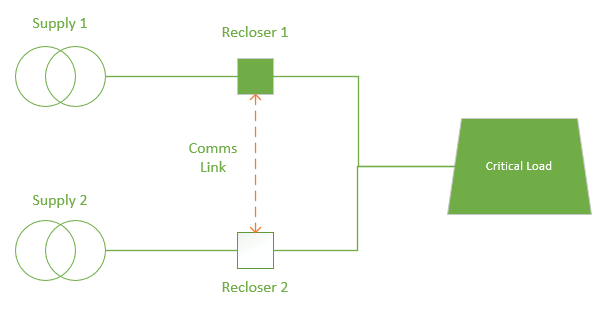#42 Marcela St., Damong Maliit, Brgy. Nagkaisang Nayon, Novaliches, Quezon City 1125, Metro Manila, Philippines

Essentially, we covered the basic automation scheme where a critical load, be it a hospital, stadium, or even a town, where two alternate supply feeds are controlled by reclosers sensing the voltage presence on either side of their internal circuit breaker.
Now whilst this system is the cheapest, most simple system for implementing an automation scheme, it does have one major drawback: if the fault is in the critical load, without communications the devices will execute at least one extra close onto the fault.
The primary reason being that the Normally Open (NO) recloser has limited scope to detect if there was a downstream fault while it was open, as the fault current is not flowing through the NO recloser. It will then close onto the fault to attempt supply restoration, before tripping on protection itself.
Solving the Close-Onto-Fault Scenario:
Simply, to stop closing onto faults, the reclosers need to be able to inform each other of fault passage, blocking the automation when a downstream fault occurs. This Peer to Peer communications scheme is so common in Recloser applications, that NOJA Power’s OSM Recloser system has a dedicated ACO function designed to achieve this as standard.

Figure 1 – A dedicated ACO Function
To implement this scheme, a communications link is created directly between the two Reclosers. For an OSM Recloser system, this can be a copper Serial connection with RS232 or RS485, or an IP based communications scheme using WiFi, 4G/3G, Ethernet or Fibre Optic Communications.
This communications link allows the reclosers to report when they tripped due to loss of supply vs when they tripped due to a downstream fault, allowing the system to proceed for restoration but disable when a downstream fault is detected. This solves the key drawback of the communications’ free topology.
When communications between the devices are commissioned, further benefits can be unlocked, such as resolving the operational issues of managing an automation scheme. Field teams can visit a single recloser and read the state of the other unit in the automation pair, allowing for safer operation and field-based disabling of the automation at a single site when works are required.
Benefits:
By adding communications between devices, we solve the key drawback of a communications-free automation setup, with the added benefit of controlling the entire automation scheme at one location.
The communications infrastructure required for this development can be relatively minor, particularly if the two reclosers are in close geographic proximity to each other. NOJA Power offers an upgraded version of the RC control cubicle, the RC15, which ships with Wi-Fi and 4G integrated into the system. These units can directly link over Wi-Fi to achieve this automation scheme.
The application is also common for underground networks, with NOJA Powers Auto Changeover GMK product providing a single pad mount kiosk with two reclosers and controllers inside, connected in a topology with two incomers and one outgoing feeder. This unit can be used to achieve the above scheme in a single product.
Drawbacks
The key drawback of this implementation is the addition of communications. In areas where the geographic distance between the two reclosers becomes large and if communications are unreliable, the scheme becomes less effective. However, it remains the most popular simple automation scheme used in the electricity distribution network worldwide.
“With the release of our RC15 control, peer to peer communications is effectively plug and play with the embedded Wi-Fi and 4G capability.”, says NOJA Power Group Managing Director Neil O’Sullivan. “Customers can plug their own sim cards into the control to immediately activate automation.”